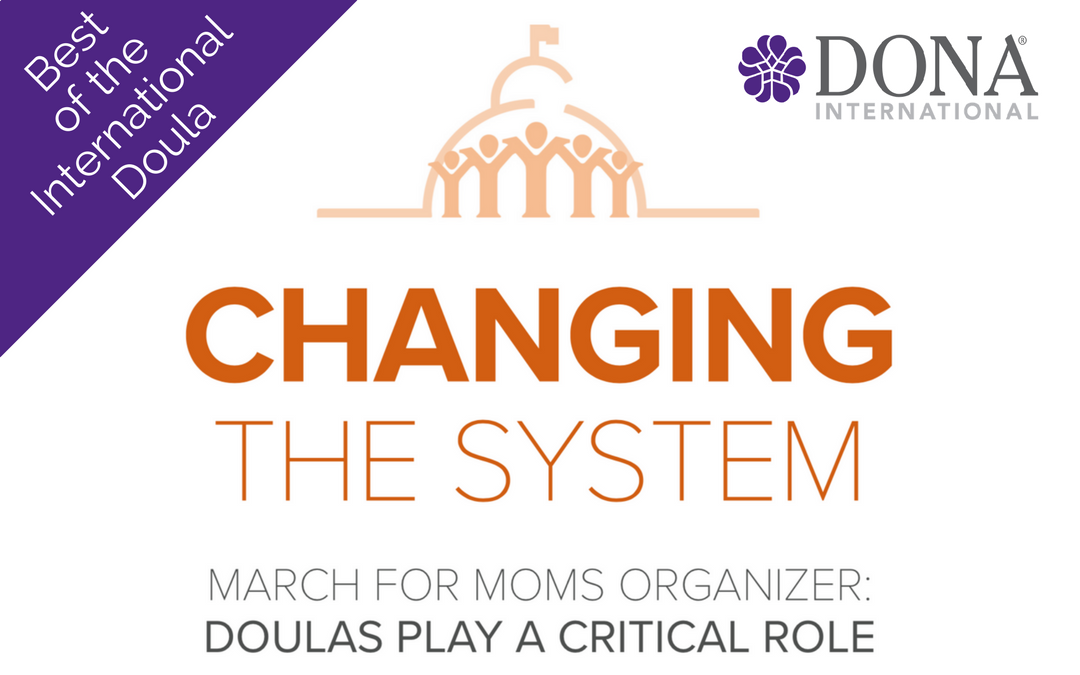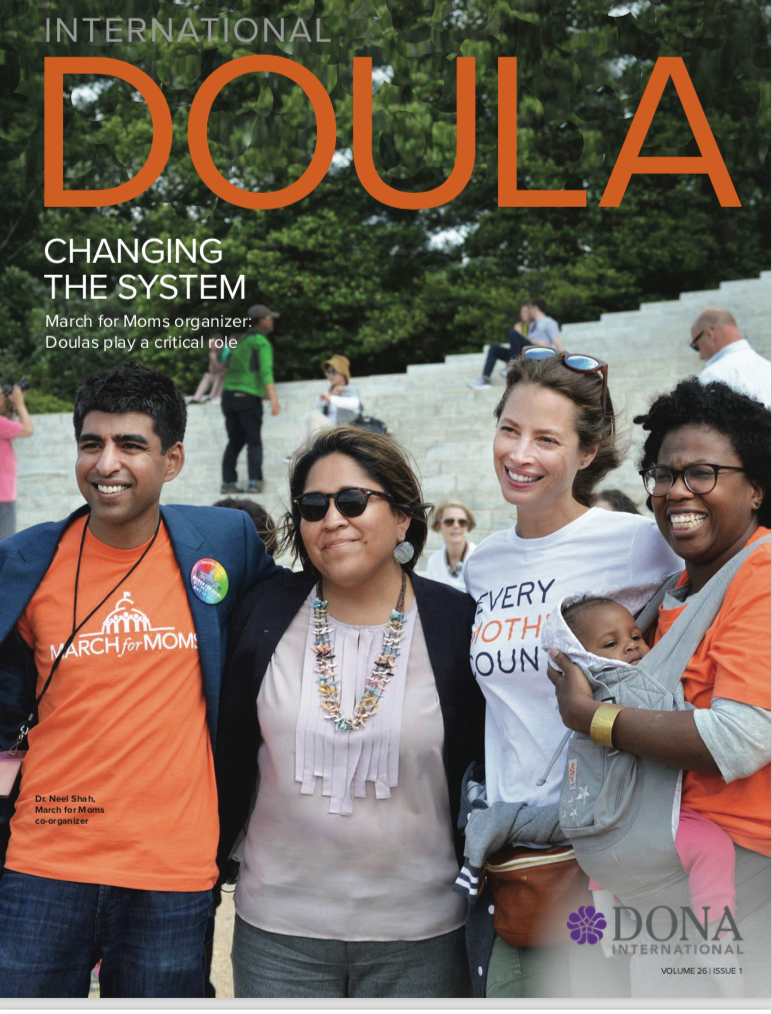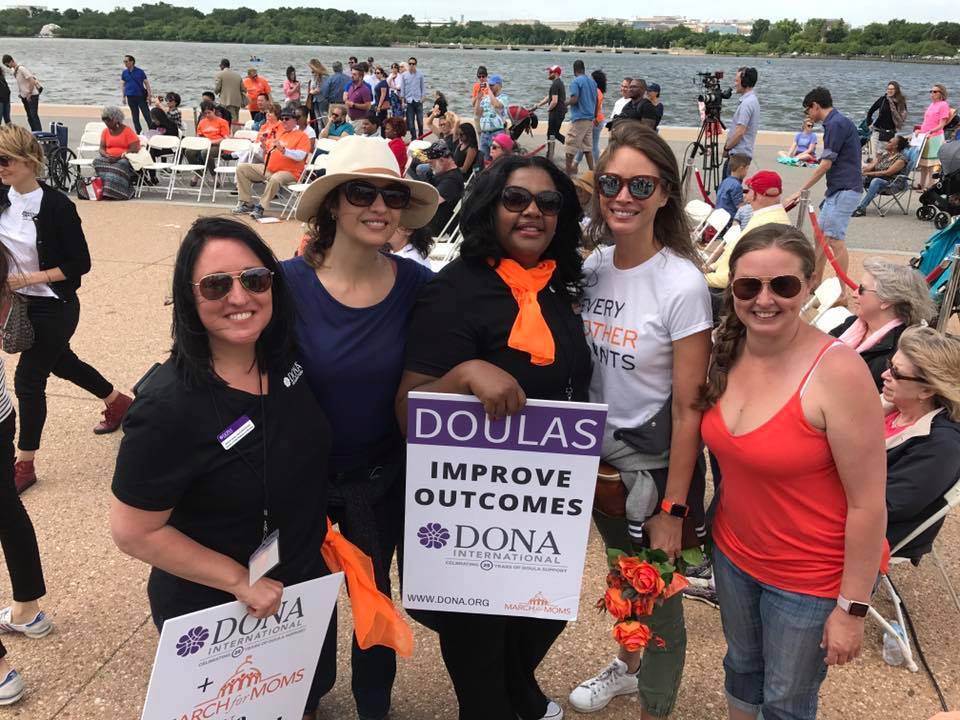By Jessica English, AdvCD/PCD/BDT(DONA), LCCE, FACCE
This article originally appeared in the March 2018 issue of the International Doula. The International Doula is DONA International’s quarterly magazine sent to each member’s home as a member benefit. They are also available online behind the member portal. You can access a special copy of this article here, for use with sharing with colleagues, clients, and community. If you are interested in receiving the ID four times a year, please consider supporting DONA International and receiving all the member benefits.
The DONA International board of directors proudly shares that we have joined forces with the March for Moms as partners for its event this May in Washington, D.C., and in communities across the U.S. The March for Moms is an opportunity for stakeholders in maternal health (providers, educators, doulas, counselors, parents, legislators, etc.) to come together and increase awareness and education about the maternal health care crisis. DONA International leadership invites all doulas to join us in our nation’s capital for this march, or in your own communities with sister marches.
Our former International Doula editor, Jessica English, spoke recently with Dr. Neel Shah, assistant professor of obstetrics, gynecology and reproductive biology at Harvard Medical School, and director of the Delivery Decisions Initiative at Harvard’s Ariadne Labs. An obstetrician-gynecologist at Beth Israel Deaconess Medical Center in Boston, Dr. Shah is one of the key organizers of the upcoming March for Moms.
Jessica English: Thank you for spending some time with us, Dr. Shah. For doulas reading this piece who might not be familiar with your work, can you please give us an elevator speech?
Neel Shah: The full scope of my work is broad, but the broadest is the March for Moms mission, trying to figure out how to get all of society to invest in the well-being of moms and birthing families. Behind that mission, there are two questions. First, ‘Why are we not investing now?’ Second, ‘How do you get people who don’t traditionally stand up for birthing families to do that?’ Underneath that are many more questions to answer about why things are the way they are.
The question at the top of my mind is why we have allowed the decision to do a c-section to become the world’s most common and consequential surgical error. They can be lifesaving, as we all know, but we seem to do many more than are necessary. Every year, of the 110 million babies born in the world, 26 million are born by c-section. So one in four babies in the world is born by c-section, and something like one in three in the U.S., and one in two in parts of Latin America. And the consequences are equally significant — surgical complications, infections, hemorrhage and risks to future pregnancies from uterine scarring.
JE: From a doula perspective, we see it, we hear you and we’re with you. What’s the doula’s role in this mission?
NS: Like most other obstetricians, I was trained in a tertiary academic medical center, and doulas were not common. When we did work with doulas, I don’t think I had a strong opinion either way. But often there wasn’t a clear understanding of where the doula’s role ends and the nurse or midwife or clinician’s role begins, and that boundary can sometimes make the relationship seem adversarial.
After I finished my training, I started to think more deeply about this problem of skyrocketing c-section rates. I wanted to understand what’s driving it and what’s not driving it, and then what could be done about it. It’s a complicated, knotty issue. But through that discovery process, I found out about DONA International and was invited to speak in Seattle. I read Penny Simkin’s book [The Labor Progress Handbook] and thought, ‘Oh, wow, this is genius!’ I admire people who see a better way, and not only see it clearly but also try to build a possible solution. That’s exactly what she has done. We need more people with the courage to think differently like Penny.
In trying to follow her lead, I started just listening and then thinking about what was exceptional about childbirth compared to other areas of medicine. Why does childbirth in the U.S. not have the advocacy and organized coalition like there is for breast cancer? Why is childbirth so undervalued compared to cardiac care?
JE: Right. Why is that?
NS: One big reason is that we have collected maternal health issues, reproductive issues, and children’s issues and put them all together as ‘women’s issues.’ I don’t know why children’s issues should be considered exclusively women’s issues, but they are. Children’s health crowds out maternal health in terms of economics, and the reproductive justice debate drowns out maternal health in terms of volume. Let me be clear: they’re all important. We care about reproductive justice issues, we care about babies, we care about children’s health. But if you look at the NIH, we have the National Institutes for Child Health and Development, and that’s where maternal health lives. The majority of the funding goes for child health and development, and that’s pretty much true across the board in every part of
the healthcare system. At some point, historically, we just defined women’s health issues in a counterproductive way that doesn’t leave room to invest in the wellness of mothers.
JE: That might lead us right into what the doula’s role will be in changing the maternity care system and helping to lower the cesarean rate, which I know is an important part of your work. We know there are a lot of power dynamics in working within this system. How do you see the doula playing a unique role, and how can we best build relationships?
NS: We know there’s a critically important set of skills and services doulas provide. Why would someone run a marathon without a coach? Doulas can help to relieve some of the burdens for the family caregivers.
There’s the role of the doula in the moment, providing labor support, hopefully collaboratively with the other labor clinicians and with the mom herself. There’s also a real agency problem in childbirth. In the moment where you’re in the midst of labor, it’s really hard to advocate for yourself. It’s a lot to put on moms. Having a trusted person who understands legitimate preferences and who can be a bridge of communication is important and goes beyond a coaching role.
There are so many fragments of the system that have to be built up together. At the core of it, this communication is key. The birthing person, the support people (professional or personal) and the delivering provider need to have the same shared mental model of what’s happening. We actually know what to do to decrease c-section rates, we have the will to change, and there is real money on the table to do this. So why aren’t we applying what we know everywhere, and reliably? What’s the gap between the knowledge we have and getting it done?
In caring for women in labor, we often don’t seem to have clarity on what our shared goals are. When I hear midwives and doulas talk about the goals, they’re not wrong — they are just insufficient. Support and agency alone are not enough. When I hear many obstetricians talking about the goals, they aren’t wrong either, but they are also insufficient. For example, ‘Moms and babies ought to be safe in labor.’ If you were to articulate that as the goal for most obstetricians, they’d reply, ‘Yes. That’s what I’m doing.’
JE: Yes, we hear all the time, ‘Healthy mom, healthy baby. That’s all that matters.’
NS: Done. Right. So what’s wrong with that? Those are great goals, and everyone wants moms and babies to be safe. But if you only articulate those goals, it creates a false choice between the mom and the baby, No. 1, often where it doesn’t exist. No. 2, it ignores the fact that moms have goals in labor other than emerging unscathed, which is where doulas come in.
When I think about explaining a doula’s role to our colleagues, I would love to have a more distilled description of who the doula is and what they do professionally — like the value-added services — that would really translate across the board. It’s not an easy task, but it’s not an impossible one, either. Childbirth is a moment of either incredible self-agency or complete lack thereof. And you can see both versions as a doula. You can see what it’s like when someone feels really empowered that they just gave birth to a human being, and you can see what it looks like when that process is disempowering and how that affects people.
Underneath that, the reason it matters so much is that childbirth is a moment of identity formation as a mother. Whether it’s the first time or 10th time, it matters. People will tell you their birth story, no matter how long it’s been, as soon as they hear what you do. We have to be able to address that.
There’s also an area of alignment in supporting vaginal birth with the shared clinical goal of producing more health — particularly for the first birth. There’s a moment in the labor of a first-time mom where the provider can set up the mother and baby for the best long-term health if she can avoid an unnecessary c-section. Providers have that opportunity, and there’s not a clinician in the world who would not take that opportunity if described in that way.
JE: It’s the most important birth, isn’t it, because it impacts everything down the line.
NS: It absolutely does.
The doula necessarily has a role in advocating, and I’d like to see a structure where it doesn’t seem adversarial to advocate, where we’re all pulling toward the goals everyone agreed to. But to do that, first you have to articulate what that next goal is beyond the safety of the mom and the baby.
JE: I’m hearing you say that among your physician colleagues, you’re advocating for that next goal of the long-term impact emotionally and physically on the birthing person and the baby, and you’re also advocating for the doula’s role in all of this. How’s that going? What kind of reception are you getting, and do you see it shifting?
NS: We’re making great progress. It may not always make sense to lead with, ‘We need more doulas,’ even though we do. Sometimes it’s better to lead with the goals and the model of care that support that goal — the stuff that’s harder to argue with. Once we all agree on the goals, doulas and midwives and birth centers and other options become a necessary part of that solution.
Here’s a statistic that drives this home for me. Research tells us that RNs can only spend about 10 percent of their total time in the room with the patient, and in most settings, they’re the primary support. Similarly, most moms go into their birth thinking that the person they saw in the office is going to deliver their baby. And in most cases in 2018, that’s not going to happen. I’m part time now, so most of the moms I take care of in the office, I’m not there for their delivery. I ask them after their babies are born about their experience, and most of them don’t remember the OB who attended their birth. Many of them do remember the nurse, and she, theoretically, spent 10 percent of her time in the room. But even that is so appreciated, right? That’s striking to me because most of those nurses seem like they really want to be spending more time in the room, but for a variety of reasons they are unable to. Do we just leave moms in the lurch, or do we try to fill that void?
Honestly, even if the nurses could stay longer in the room, I think there’s still a role for doulas, particularly in these complex environments. In a birth center, where the midwife is both your birth support and a clinician, it’s possible that one person could do everything. But in hospitals where there are many things going on outside the room, having one person whose sole responsibility is thinking about your wellbeing is a big thing.
JE: The times I’ve seen the relationship work really well, doula-nurse-doctor, there’s a recognition and appreciation of what every person brings to that birth space. But it takes a lot of trust and relationships, and intention on the doula’s part to not go beyond their scope of practice. I think DONA really excels in that area by giving our doulas structure around how to do this most skillfully and cautiously. Because when doulas step outside of that, the relationship is ruined.
NS: Yes, there is tremendous responsibility vested in you as doulas. Doulas have the trust of the birthing family and, in many cases, the trust of the health care system, too. But we certainly have more work to do to continue building this trust, to communicate what the role and the value-added services of doulas are in a way that translates for clinicians.
JE: Agency is at the heart of what we do as doulas. Our Code of Ethics and Scope of Practice state that the interests of the birthing person come first for the doula. What does this person want, and how we can we help them manifest their agency in their own birth?
NS: Well exactly; that’s the key reason that doulas are and always will be so important.
JE: You and your wife had a baby yourself recently. How has becoming a father changed your perspective on all of this?
NS: Oh wow, parenting is humbling in so many ways. Every patient who comes back for her postpartum visit should
get a medal because those first couple of months are crazy. Everybody does it, so I thought, ‘Well, I guess we’ll do it, too. But those first few months are hard. Mostly what it taught me is what’s at stake, honestly. Before I had a son, the challenges in maternal health seemed unjust, and it seemed like something more people should care about and something we should do better, but it didn’t feel as personal. But now I have an even deeper stake, and I have a better understanding of why we need to do better.
JE: Before we end our discussion, I’d like to touch on health disparities, racism in the system and the effects on women of color. How does that fit in to your work?
NS: For every outcome, we care about in maternal health, there are tremendous racial disparities. Even when you try to tease apart social dynamics, economic dynamics, there is an independent component of it that’s a racial dynamic.
Although it is a very complex issue, the lowest-hanging fruit for all of us who work on the frontlines of healthcare is try to recognize the implicit bias we all carry. There is good data that we undertreat the pain of our black patients, we interpret their symptoms differently whether we mean to or not. Serena Williams’ story is a great example; even being a world-famous professional athlete doesn’t seem to spare you from this bias.
JE: What would you like DONA International doulas to know about our part in helping to make change within the system?
NS: There’s no better grassroots army for making the maternal health care system better than doulas. I think to be a doula, you have to be somebody who cares about these issues on a deep, profound level. It’s not purely academic. There’s something personal there, and doulas are motivated by something that’s likely to stick when the going gets tough, whether it’s in the room with a client or in society in general. Being a doula seems exhausting to me as an obstetrician. It’s not a job that I would do well. I don’t mind flitting in and out of the room. I think I’d be exhausted if I did what doulas do, but it’s so necessary and so critical.
There’s the DNA of the kind of person who becomes a doula, both in endurance and in passion. So I’d say the work that you all do is so critically important, not just because of the technical skills, but also because of who you are. It seems obvious to me that anyone who wants a better world would want the people I’ve met at DONA International to be leading the charge.





